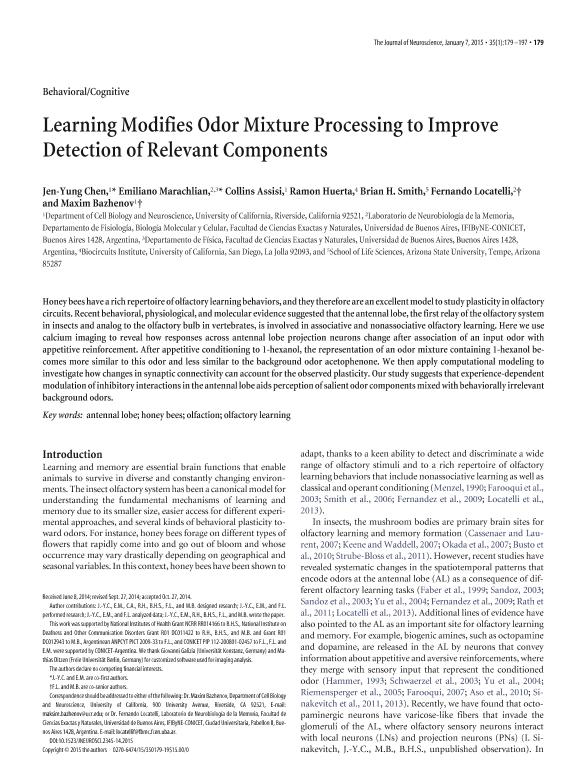Artículo
Learning Modifies Odor Mixture Processing to Improve Detection of Relevant Components
Chen, J. Y.; Marachlian, Emiliano ; Assisi, C.; Huerta, R.; Smith, B. H.; Locatelli, Fernando Federico
; Assisi, C.; Huerta, R.; Smith, B. H.; Locatelli, Fernando Federico ; Bazhenov, M.
; Bazhenov, M.
 ; Assisi, C.; Huerta, R.; Smith, B. H.; Locatelli, Fernando Federico
; Assisi, C.; Huerta, R.; Smith, B. H.; Locatelli, Fernando Federico ; Bazhenov, M.
; Bazhenov, M.
Fecha de publicación:
01/2015
Editorial:
Society for Neuroscience
Revista:
Journal of Neuroscience
ISSN:
0270-6474
Idioma:
Inglés
Tipo de recurso:
Artículo publicado
Clasificación temática:
Resumen
Honey bees have a rich repertoire of olfactory learning behaviors, and they therefore are an excellent model to study plasticity in olfactory circuits. Recent behavioral, physiological, and molecular evidence suggested that the antennal lobe, the first relay of the olfactory system in insects and analog to the olfactory bulb in vertebrates, is involved in associative and nonassociative olfactory learning. Here we use calcium imaging to reveal how responses across antennal lobe projection neurons change after association of an input odor with appetitive reinforcement. After appetitive conditioning to 1-hexanol, the representation of an odor mixture containing 1-hexanol becomes more similar to this odor and less similar to the background odor acetophenone. We then apply computational modeling to investigate how changes in synaptic connectivity can account for the observed plasticity. Our study suggests that experience-dependent modulation of inhibitory interactions in the antennal lobe aids perception of salient odor components mixed with behaviorally irrelevant background odors.
Palabras clave:
Olfaction
,
Plasticity
,
Coding
,
Imaging
Archivos asociados
Licencia
Identificadores
Colecciones
Articulos(IFIBYNE)
Articulos de INST.DE FISIOL., BIOL.MOLECULAR Y NEUROCIENCIAS
Articulos de INST.DE FISIOL., BIOL.MOLECULAR Y NEUROCIENCIAS
Citación
Chen, J. Y.; Marachlian, Emiliano; Assisi, C.; Huerta, R.; Smith, B. H.; et al.; Learning Modifies Odor Mixture Processing to Improve Detection of Relevant Components; Society for Neuroscience; Journal of Neuroscience; 35; 1; 1-2015; 179-197
Compartir
Altmétricas



